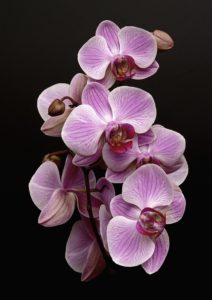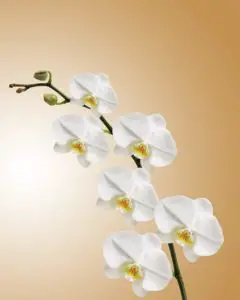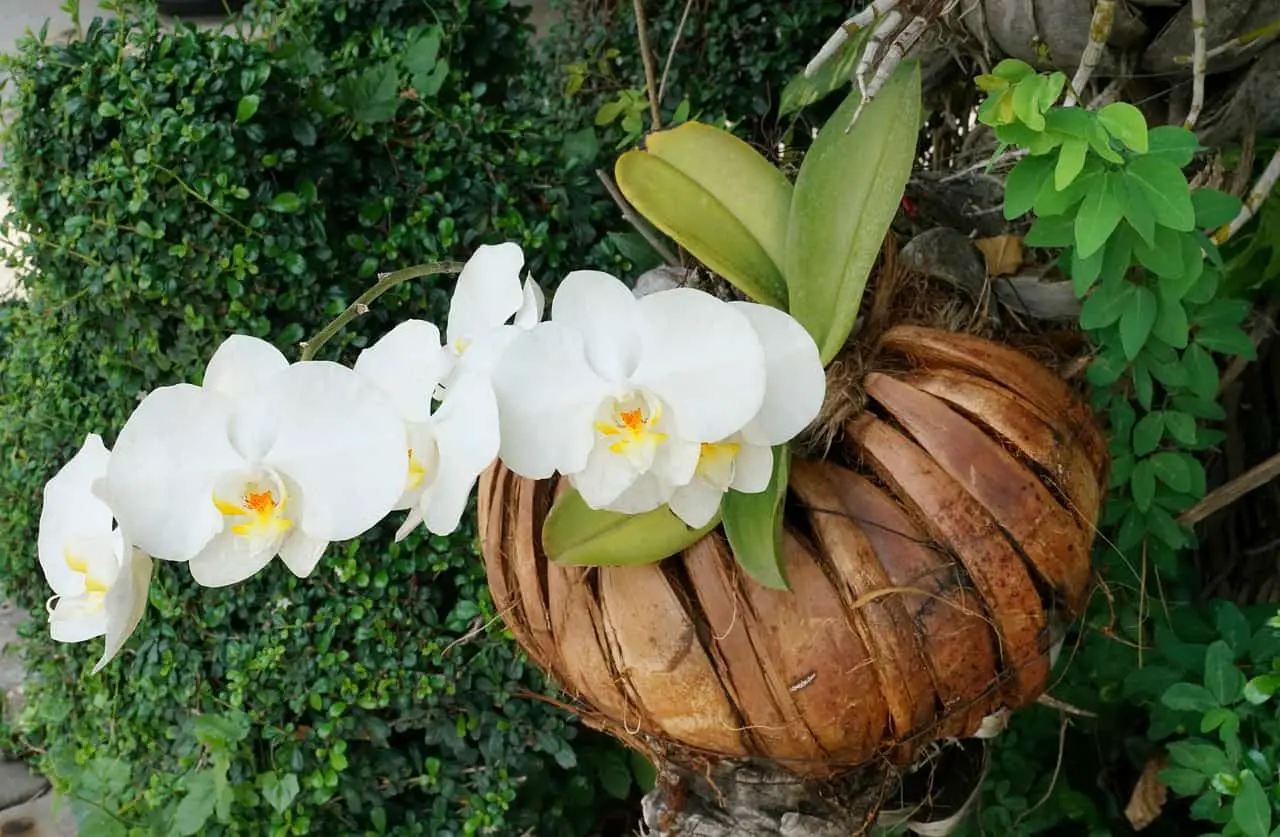Some links in the post are affiliate links and I get a commission from purchases made through some links found in the post.
How have you been growing your orchids or any other flowers for that matter? Often, people talk about not having the ideal positioning for their flowers.
They try and make do by having the plants under lights or pushing them to the corner as near a window as they can.
Well, the good news is that you do not have to resort to these tactics. You can plant your orchids in hanging baskets.
Not only does this solve the positioning problem, but it also adds to the aesthetic appeal of your display.
And no, caring for such flowers will not be that much harder than traditional planting methods.
From saving space to beautifying your space, there is so much that planting orchids in hanging baskets can do for you.
Today, we cover everything from choosing a basket to selecting the right orchid through to positioning the basket. For a quick guide:
- Choose the hanging basket for your orchid
- Place a filler inside the hanging basket
- Prepare the medium for your orchid
- Plant the orchid in the medium
- Add sphagnum moss as a top layer
- Hang in an appropriate place for the variety of orchid
What Hanging Baskets can you use for Orchids?
 Before we get into selection, what is a hanging basket? You probably already know what it is or have seen some visuals or the actual hanging basket.
Before we get into selection, what is a hanging basket? You probably already know what it is or have seen some visuals or the actual hanging basket.
A hanging basket is a structure suspended from the ceiling or other high places using chains, ropes, and other materials.
These structures feature decorative plants such as orchids and are ideal for saving space and adding beauty to space.
Baskets come in varying shapes, styles, and materials. The good thing is that these baskets pave the way for creativity.
Instead of going for what is available on the market, you can also DIY a basket using readily available materials.
The key factor here is to get the size right. If not, you will end up having to regularly water and prune the plant for it to grow right.
A big basket boasts of more water retention and allows you to lessen the maintenance work. Keep this in mind unless you do not mind upping your maintenance tasks.
Types of Baskets
Wire & Metal
If you are in the market for a sturdy basket, this will do. You can line this with moss, coir, and other liners.
We will get into liner selection later and why it matters. These kinds of baskets do not retain much water and call for regular watering to avoid drying out of the plant.
If you want the basket to retain more water, try adding a saucer to the bottom. You can also have some crystals at the bottom of the compost to help retain the moisture.
Wicker
These baskets are also quite sturdy. For these, you will get the best results from using a plastic liner, which aids in better water retention.
Plastic
Did you know that plastic is also an option? These baskets are easy to use and fair well regarding water retention.
However, you should note that these tend to be unsightly at first and can be a bit of an eyesore.
But once the orchids are mature and have filled the basket, the unattractiveness will reduce.
You can also get a plastic basket that matches the orchids’ color to help with the seamless effect.
Ceramic & Terracotta
If you want a basket that makes your space look great, this is an ideal option.
Away from the aesthetics, these options tend to dry out quickly and call for regular watering.
Also, note that they are heavier than most baskets and will require a strong wall bracket. The last thing you want is a basket toppling down on anyone.
Old Chip Baskets & Colanders
As we stated earlier, you do not have to get a basket at the store. Look around you and think of what you can do with the old materials around you.
A little bit of DIY is what you might need to transform your space in a few simple steps completely.
Liners
The lining of your basket also matters as it determines how much water remains in the soil.
You do not want to retain too much water, and neither do you want the soil to dry out too fast. Here are some liners you can use:
Sphagnum Moss
This sphagnum moss is excellent in water retention owing to its thick texture, which features dry and empty cells.
Additionally, it is naturally free of bugs and insects, making your maintenance work easier. On the downside, working with this thick texture can be challenging.
Cocoa
For tidiness, this would be a good choice. Often, people get this pre-made so that they can fit specific baskets.
They are also thick, and this can complicate side-planting. Thus, if you want flexibility with the planting, this liner might not be the best option.
Burlap
Flexibility might be the key to your orchid planting. If this is the case, try and work with this material that is not only flexible but also cheap.
Furthermore, it is eco-friendly, making it ideal for anyone into organic gardening.
On the downside, this material has poor water retention, and you will need to water your plant regularly.
Supamoss
Many gardeners use this liner, and not for naught. It has holes that allow adequate drainage while retaining enough water for the plant.
Also, it has a natural look even though its make is quite artificial, featuring a plastic build. Flexibility is also possible with this liner, enabling you to work it based on your orchid plant.
Points to Note
Regardless of the type of basket, a strong wall bracket will be necessary. The moment you water the plant, the basket becomes heavier, and it is thus quite risky to rely on standard wall brackets.
If you are enjoying this article, check out our article on how can you prevent curled or wrinkled orchid leaves.
Where can you Hang your Orchid Hanging Basket?
 Where you hang your basket will depend on the kind of orchid you choose.
Where you hang your basket will depend on the kind of orchid you choose.
Orchids thrive differently. Some will do well in the outdoors, while others will fail to thrive in such conditions. It comes down to the kind of orchid you choose, as we will cover later.
However, the general rule is that an orchid will take time to adapt to the hanging basket.
As such, if you keep it indoors, it will do better owing to the reduced adaptation period.
Here, you have control over conditions such as lighting, humidity, and temperature. But in the outdoors, you have no control, and the plant will take time to adapt.
The thriving will depend on the plant and how suitable the conditions are.
The temperature should range between 15 and 24 degrees Celsius for most orchids, ensuring that it gets about 10 hours of daylight a day.
Note that most orchids do well in indirect sunlight but will burn with direct sun exposure. As such, position the basket accordingly towards a south or east-facing window.
Humidity levels should be at 50-70% at all times to mimic the tropical climate to which the plant is accustomed.
Generally, the plant should thrive in the display for two years. However, in the outdoors, this span may be shorter or longer.
If you are planning on hanging your basket from brick without drilling, check out this article.
How to Choose the Right Orchid for your Hanging Basket?
Here is an interesting titbit – there are more than 40,000 species of orchids! And these have different growing needs.
Thus, your search for the right plant for your basket should be interesting. It helps to note that some species are easier to grow than others and are best for beginners.
Choosing an orchid based on prevalent conditions makes its growth and nurturing much easier. Here are the conditions to keep in mind:
Temperature
Where will you grow the orchid – indoors or outdoors? What is the temperature of the chosen space?
You can easily figure this out using a thermometer. For temperatures between 7 to 12°C, you can work with Cymbidium, Dendrobium, or Odontoglossum.
From 12 to 16°C, you can select Cymbidium, Dendrobium, Paphiopedilum, Miltonia, Oncidium, Phragmipedium (lady slipper), or Vanda.
With hot climatic conditions of 16°C or higher, Angraecum, Phalaenopsis (moth orchid), or Ascocentrum can work.
Lighting
All orchids require light. However, their needs are different. Some do well in indirect light, while others want direct and bright light.
Angraecum, Vanda, Cymbidium, Dendrobium, and Ascocentrum are great examples of plants that can do well in bright spaces.
You can position these baskets towards south-facing windows. On the other hand, some plants are better off with some shade and should be towards east-facing windows.
These include Paphiopedilum, Phalaenopsis, Phragmipedium, Miltonia, Oncidium, and Odontoglossum.
Spacing
While hanging baskets save space, you should still consider the size of the orchids you want in your home.
Some plants, like Dendrobium, Phalaenopsis, and Cattleya, grow tall and require a lot of space.
Others are best for small spaces as they grow to small lengths. A good example would be Ascocentrum.
Selection Tip
When choosing an orchid, you can get all the above requirements right only for the plant to fail.
You must ensure the orchid is healthy by assessing the overall state of the plant. Its roots should be green, and so should its leaves.
A bit of yellowing on the leaves is not a major issue as this can indicate slight dehydration. But too much yellowing is an indication of neglect, pests, or diseases.
You may also like: Are blue orchids real?
What you Need to set up your Hanging Basket
 For one, you should not remove the orchid from its pot; else, the plant will fail. Orchids do not thrive with free roots and prefer to have their roots bound.
For one, you should not remove the orchid from its pot; else, the plant will fail. Orchids do not thrive with free roots and prefer to have their roots bound.
However, Vandas are an exception to this rule. The pot can be a bit unsightly, but you can cover this by using some moss or other material.
Also, having a pot in the basket makes it easier to water the plant and apply pesticides and insecticides.
Secondly, having each orchid in a pot allows you to separate ailing plants from the others.
It is unlike having orchids in one pot as this would create quite a challenge in separation.
So, how should you hang your basket? Well, you can use the original pot and attach wires to it to aid with attachment.
The downside to this is the lack of appeal, though it can contribute significantly to space savings.
You can counter this aesthetic problem by getting a beautiful pot from the get-go and using nice wires.
The Other Option is to Start from Scratch:
- First, decide on the type of basket and liner as we outlined earlier. For example, with Vandas, you can work with a wooden basket.
- Next, decide how many orchids you will have in the basket. You can have more than one, as long as the pots remain separate for ease of removal. When having multiple plants, it is best to work with the same species as they will have similar growing needs. Thus, when watering, positioning, and caring for the plants, you will not have to do much tailoring. Also, it ensures uniformity in the longevity of the basket display.
- Thirdly, you will need some filler to hide the appearance of pots for a seamless look. The basket should appear as if the plants are unbound in the basket.
- And finally, you will need a hook or attachment to keep the basket in place. A chain also works in helping with the height regulation.
How to Plant your Orchids in your Hanging Baskets
With the materials ready, the work can now commence as follows:
Basket Preparation
Start by drilling some holes on the side of the basket to increase air circulation. Then take your choice of liner and spread it at the bottom of the basket.
Ensure that it is thick enough to withstand the weight of the pot. This liner aids in retaining water to keep the humidity levels at an optimum and prevent the drying out of the arrangement.
Lining the Basket
Place the pot with the orchid inside the basket on top of the liner.
If you want to have more than one pot, ensure they are close and that the flowers are on an equal level height-wise for tidiness and uniformity.
This levelness aids in watering and fertilization. If one pot is higher than another, the higher pot ends up benefiting more from aftercare practices, which affects the display’s longevity.
You can add more liner at the lower pot’s bottom to bring it to a higher level.
Securing the Pot
You need to secure the pots so that they do not move. As you do this, you should also place some materials around the pots to reduce their visibility.
You do not have to go to the store for this and can use materials from home, as long as they are airy.
Compact materials like potting soil will reduce air circulation and affect the orchids. Make sure the item used is airy and can provide adequate support to the pots.
Layering
Add moss or other material to the top of the pots to create the illusion of continuity.
This layer also increases humidity, further enabling the plant to thrive. Without it, you will need to water the plants more regularly.
How to Hang your Orchids in Hanging Baskets
This last step involves deciding where the basket will be. Suppose you hang the basket high up near the ceiling; the plants will not get most of the morning sunlight.
As such, you should position the basket to about ¾ the distance between the floor and ceiling.
That should enable it to get some shimmers of light in the morning without serving as a distraction to people passing underneath it.
The basket should also not obstruct your views of the outside. Finding this balance is the key to having the basket be part of your seamless aesthetic decor.
The chain is necessary for this process. Once you have attached the basket to your ceiling or other parts near the roof, you can use the chain for adjustment.
You can move the plant up and down as is necessary for it to have enough light.
So, where can you hang the basket? Anywhere, as long as you keep the growing conditions in mind!
From your porch to your fence, it all comes down to the type of orchid you plant.
Be creative and find ways to get the basket to work for you. You can even use hooks and stick the basket near the ground around your garden.
Final Thoughts: Planting Orchids in Hanging Baskets
 Planting orchids in hanging baskets should not be much of a hassle once you get the requirements right.
Planting orchids in hanging baskets should not be much of a hassle once you get the requirements right.
You have to keep in mind that these plants will still have pretty much the same requirements as those growing in the garden.
Watch out for yellowing, as this indicates issues with watering. You may be giving your plant too much or too little water and may need to adjust the watering amounts or frequency.
Try and water the orchid once a week and allow it to dry out before watering it again. During warm months, you may find it necessary to water the plant more often.
However, always wait for it to dry out first. Also, sunlight may be too much or too little. And in some cases, it is a matter of the life cycle.
However, being keen on changes is the only way to keep abreast of how well your plant adapts to the new environment.
While you are on it, be sure to monitor the fertilization and humidity levels as per the orchid species’ needs. Happy gardening!
If you enjoyed this article, check out our article on how do you take care of a bleeding heart in a hanging basket.

